H DESIGN:古砖窑的文化民宿设计

江南,自古被人们称为人间天堂,这里河湖交错,水网纵横,小桥流水、古镇小城,其中坐落在江南如诗如画风景中的锦溪祝家甸,是一个拥有两千多年历史的江南水乡古镇,素有“中国民间博物馆之乡”的美誉。在锦溪,一直有这样一个说法:“三十六座桥,七十二只窑”。这里曾经遍布制作金砖的窑厂,其金砖文化和古窑文化成为了锦溪历史文化中浓墨重彩的一笔。
Jiangnan of China, has enjoyed the”earthly paradise”reputation since ancient times of its staggered rivers and lakes, vertical and horizontal waterways, small bridges and tasteful towns. A typical canal town named Jin Xi, located in the picturesque scenery of Jiangnan, known as "the hometown of Chinese folk museum" with two thousand years of history.There is an old saying here before "thirty-six bridges must have seventy-two kilns." Lots of kilns were produced golden bricks in the past, and the brick kiln culture is so profound and indispensable for the town.


祝家甸村位于五湖三荡的锦溪,苍茫一色的长白荡西侧,现存明清古砖窑十余座,虽然大多已荒弃,但是尚有几座还在使用。由于生产规模急剧萎缩,村落空心化趋势日益严峻,曾经繁华一时的土地,已然失去了往日的光辉。为了让这片重点历史文化区重新焕发生机,H DESIGN受邀负责整个锦溪祝甸村古砖窑项目的室内设计,包含古砖窑文化馆和主题民宿两大部分。
Zhu Jiadian village is located on the west side of Jin Xi, still exists more than ten ancient brick kilns of Ming and Qing dynasty, although most of them have been abandoned, but a few are still in use. As the scale of production shrinks dramatically, the trend of hollowing out of the village becomes increasing seriously, the bustling land has lost the glory of the past. In order to make this historical and cultural village newborn, H DESIGN was invited to be responsible for the interior renovation of an old large-scare brick kiln including a cultural museum and a folk inn.


一期的祝家甸村古砖窑文化馆面向长白荡方向临水而建,提供了亲水宜人的休闲环境。砖窑主体一层空间被规划为轻餐饮区和小型主题课堂,二层空间为砖文化展示区、大型会议区等配套功能区,人们在光斑陆离的空间内,感受着轻松、自然、宁静的氛围。在古砖窑文化馆的一层廊下,设计师保留原有建筑风貌的同时进行了多功能空间的重组,注入新的功能与业态,包含水吧、教室、会议室等,让人们在此享受清闲的同时关注传统文化的延展性学习。
Brick kiln cultural museum was built along waterfront, facing the direction of Changbai swing, provides a pleasant hydrophilic environment. The ground floor is mainly planned as light dining area and a small-sized theme classroom; the first floor contains brick-cultural exhibition area, a large meeting room and other functional spaces where people can feel a relaxed, natural and tranquil spacial atmosphere. Under the corridor of the ancient brickkiln culture hall, the designer reorganized multi-functional space while preserving original architectural style, injecting new functions and formats such as water bars and conference rooms, where people can enjoy leisure time and meanwhile concerning the ductile learning of traditional culture.
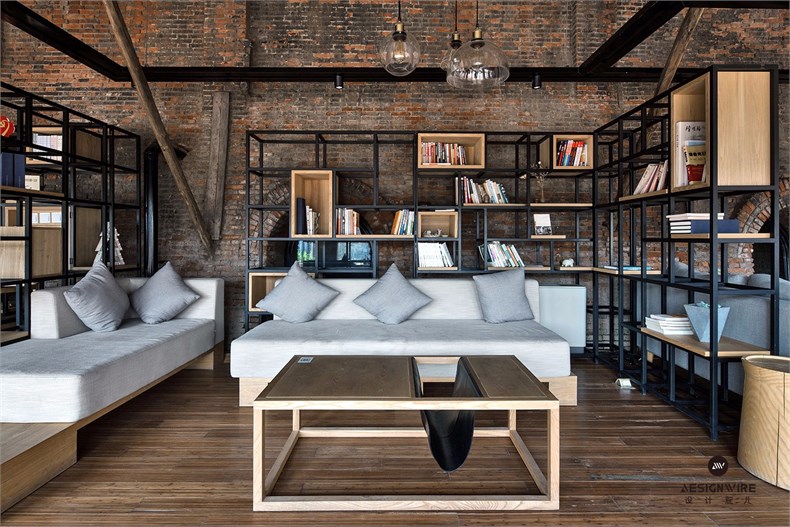

未来,这里还将作为乡伴创客学院、民宿学院等培训与交流空间,为乡村发展注入新的活力。值得一提的是,位于一层的意大利米汀Emanuele餐厅,设计结合锦溪古窑独有的地理条件,将窑洞升级成了中国首家集意餐、酒窖、雪茄吧等多种功能于一体的窑洞餐厅,为人们提供了一处别具一格的聚会休闲场所。 In the future, it will also serve as a training center for exchange of ideas among rural make-ers, boosting local rural development. Particularly worth mentioning that is an Italian restaurant called Emanuele,located in the ground floor,the designer combined with unique geographical conditions of Jinxi’s ancient kiln to create the first klin restaurant in China setting dining area, wine cellar, cigar bar and other functions, providing a charming gathering leisure place for people.
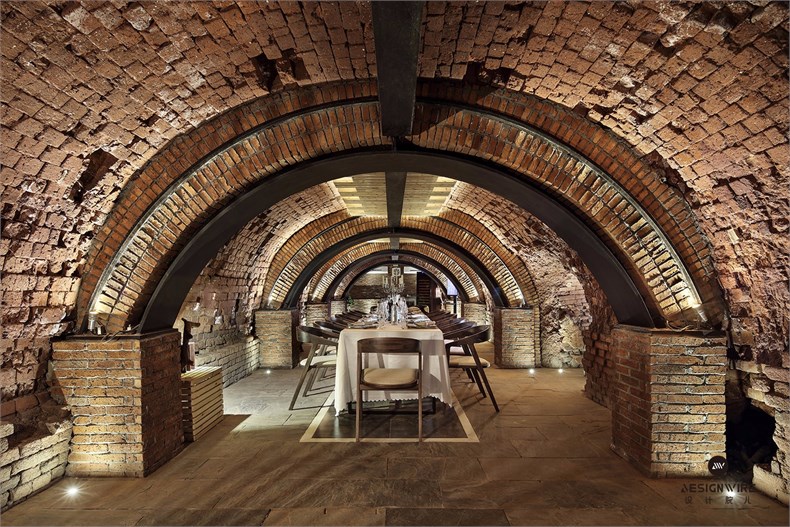
二期的砖窑文化主题民宿酒店与砖窑博物馆隔水相望,共有十栋小单体,总计二十间客房,最高为二层建筑,为轻钢框架承重体系设计,属于典型的江南民居再造。整个民宿的室内设计主调以建筑主体为索引进行延伸,萃取江南水乡文化、金砖文化及园林文化,旨在实现简约现代与老旧传统的和谐统一。为了贴近原有村落的建筑风貌,民宿及院落的设计与周边环境保持一致,保留了原先的院落空间,又针对新的功能进行了改造。设计师将以往对内服务主体建筑的辅房转而向外侧开放,形成了生动多变的街巷空间,使原本只作为交通空间的街巷可以承担丰富的公共活动。

The second phase of the project is the new-built folk inn facing brick kiln museum across the water. It totally has 10 small single buildings of 20 rooms with light steel frame system, which is the typical Jiangnan residential construction structure. The main theme of the interior design is extended with the index of architecture, extracting Jiangnan taste, brick culture and Chinese classical garden culture, aims to achieve the harmony and unity between modernity and tradition. To echo architectural style of the local village, the folk inn and its courtyard are designed in keeping with the surrounding environment, retaining original courtyard space and reworking the new functions.In addition, the designer puts auxiliary space turning to outside and open, creating a dynamic street space, so the streets and lanes these original traffic space can undertake a wealth of public activities.
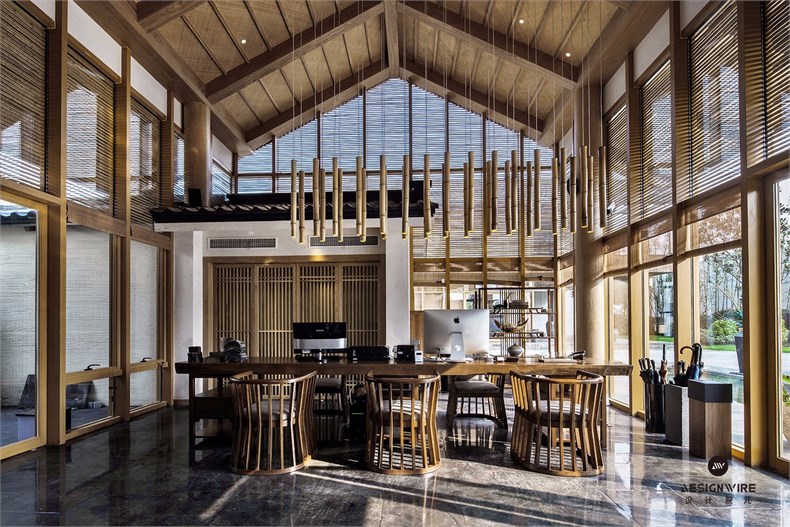
在材料的选择上,H DESIGN设计团队以砖、瓦、竹等当地乡土材料为主,并突破性地将不同材料之间进行新的组合与搭配,展现现代设计感的同时,回归材料的质朴之感。室内大量使用产自当地、低碳环保的竹材料,清新自然的材料属性赋予空间通透疏朗之感,意在表达一种崇尚淳朴与自然、注重人文关怀的现代精神;同时,局部空间以金砖作为饰面,表达了对祝家甸村烧砖历史的致敬之意。大堂区,除了使用大面积的落地玻璃,设计师采用天窗形式,为室内引入更多自然光线,伴随一天内时间的变化,光影随之在室内尽情嬉戏。而竹席与木结构打造的天花,为空间增添了几许自然古朴的味道。客房的设计采用榻榻米、书房等多样化的空间构造,配合不同主题的陈设,尽可能地将博大精深的江南文化予以细腻地展现。
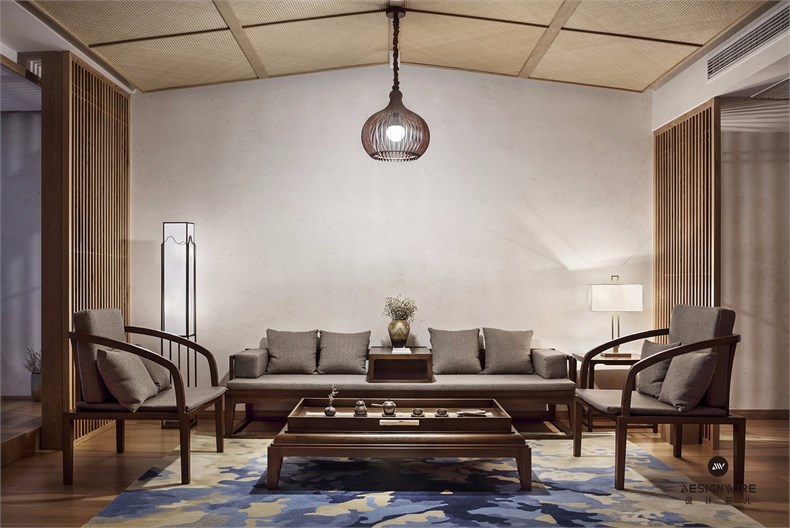
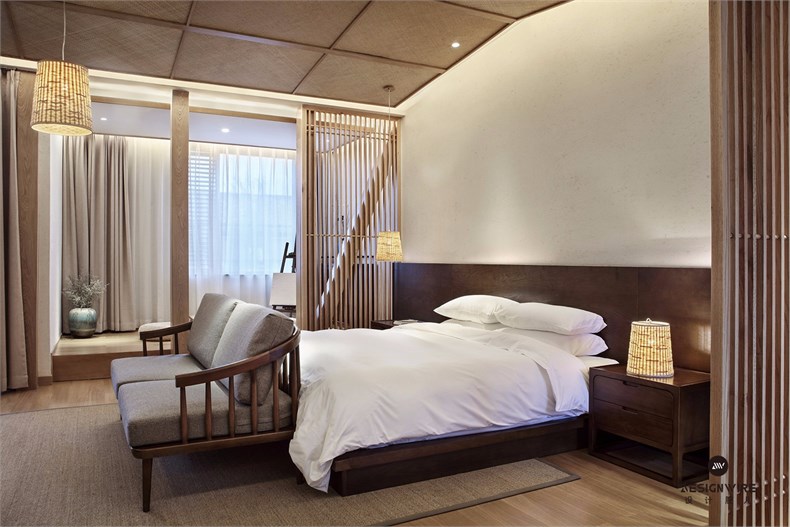
For materials’ using,the designer chose native materials such as brick and bamboo, breakthroughly combining and matching, to embody modernity of design while return to simplicity of material.Especially,large amount of low-carbon bamboo endows the space a sense of clarity with its fresh and natural characteristics, intending to express a modern spirit that focusing on nature and humane care.Some parts of spaces use local brick as decorative surface, to express respect for the history of Zhujiadian burning brick. In lobby area, except for using floor-to-ceiling glass, the designer set up several skylights to bring in more natural light to the interior. With timechanging, light and shadow would be enjoyed indoors. The smallpox is created by bamboo mat and wood structure, which adds a few natural and simple flavors for the whole space. Rooms are designed with various spatial layouts like tatami mansions and studys with different themed display, aim to make Jiangnan culture has a delicately extensive and profound unfolding.

设计师通过灵活的设计手法与创新的搭配构思,将砖窑文化以更加灵动的方式呈现于世人:“我们希望保留建筑原有的风骨,也希望通过建筑及其内部的形态来延续砖窑文化的内涵与价值,让来来往往的人记住这里一砖一窑的故事,将来,这里会进驻更多的业态,成为更多乡建者的起点”。砖窑主题民宿不仅是祝家甸砖窑文化的承载者,也是继承者,当清晨的第一缕阳光映在水面,照耀着这座带有砖窑文化的建筑,不禁让人感叹一座城,一种技艺,一方灵动,传承至今。
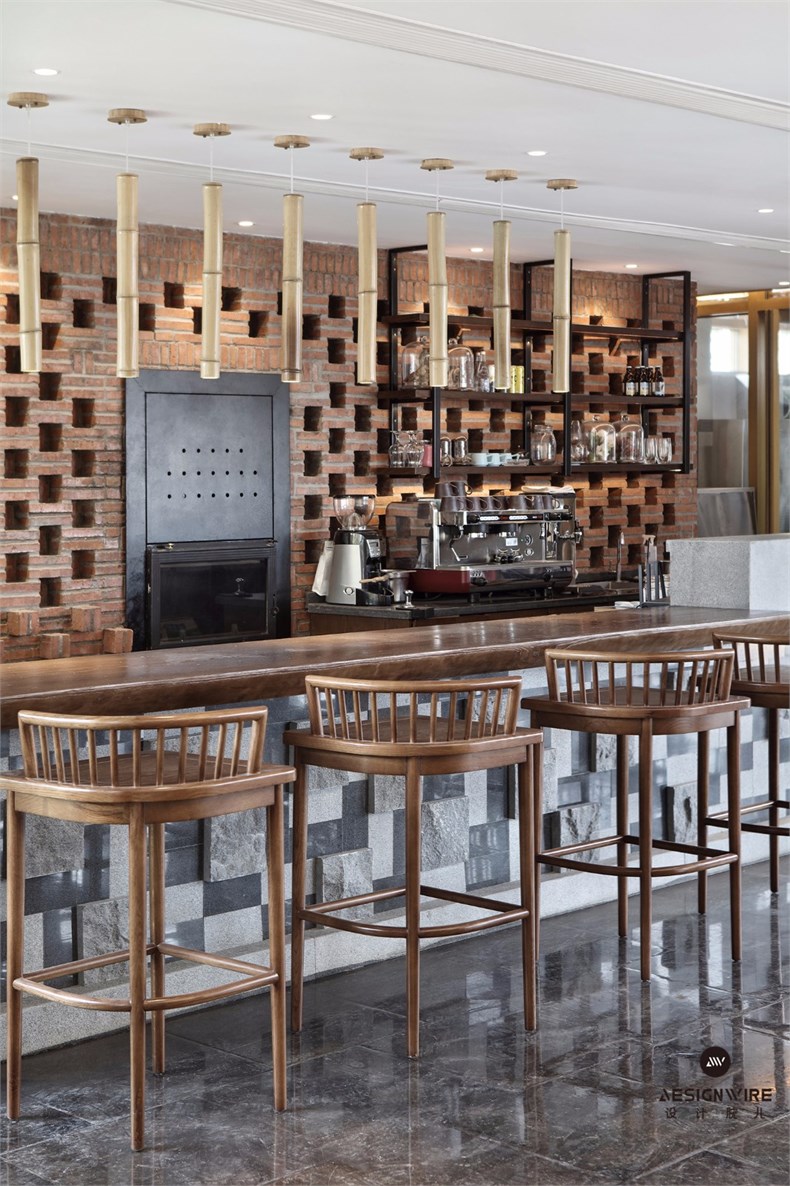
Through flexible design techniques and innovative collocation ideas, the designer wishes brick kiln culture could be presented to the world in a more intelligent way, just as he said: "We hope to keep original architectural style through its internal form , meanwhile continue the connotation and value of brick culture, so that people coming and going would remember that every story of the brick kiln here. In the future, it will be stationed in more formats and become the starting point for more township and village builders. "
室内设计:H DESIGN
设计师:胡坤(创办人)
设计团队:姜洋,吴常朴,张巍
项目地址:中国·昆山锦溪
项目面积:1520平方米(砖窑文化馆)+2940平方米(民宿精品酒店)
项目完工:2017年9月
主要材料:金砖,古金砖,红砖,天然竹,木纹铝材,热熔工艺玻璃
景观设计: 中国城市建设研究院、无界景观工作室
建筑设计: 中国建筑设计院有限公司、崔愷院士团队
Edited by Designwire


